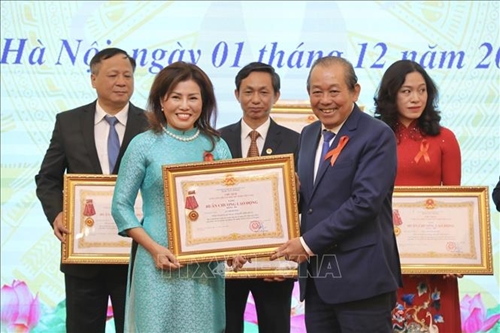Addressing a meeting held by the Ministry of Health (MoH) in response to World AIDS Day on December 1 and to look back on Vietnam’s achievements in fighting HIV/AIDS over the last 30 years, Binh said the health sector needs to bring into play all existing resources and promote the application of modern technologies.
    |
 |
|
Outstanding individuals honored at the event |
Attention should be paid to expanding coverage and improving the quality of medical examinations and treatment, consultation, and testing for HIV, he stressed.
The sector was asked to focus on interconnections in medical examinations and treatment, towards creating the conditions necessary for people to access HIV preventive services, for high-risk groups to quickly access HIV testing services, and for those living with HIV to have early access to antiretroviral (ARV) treatment and health insurance.
He called on social organizations and communities to actively and strongly participate in HIV/AIDS prevention activities, especially the provision of HIV/AIDS prevention and control services to target groups.
Government agencies need to help the Government study and build favorable mechanisms for the involvement of social organizations in fighting HIV/AIDS, Deputy PM Binh said.
He also called for more financial and technical assistance from foreign governments and international individuals and organizations for Vietnam’s efforts.
He took the occasion to praise ministries, sectors, localities, media, individuals, organizations, and the business community for their efforts and contributions to the task.
Binh expressed his belief that Vietnam will achieve the goal of basically eliminating AIDS by 2030.
Vietnam is considered a bright spot in the world for HIV/AIDS prevention and control, and is one of four countries with the best HIV/AIDS treatment.
It is also one of the first countries in the world to have a specific Law on HIV/AIDS.
International support resources have been used effectively for many years.
Reports from the MoH show that Vietnam has kept the HIV infection rate in the community below 0.3 percent, as targeted in the National Strategy on HIV/AIDS Prevention and Control to 2020 with a Vision to 2030.
Regionally, Vietnam posted the largest decline in the number of new HIV infections in 2018 compared to 2010, of 64 percent.
The number of patients under treatment has increased rapidly over the years, with 159,984 HIV carriers undergoing treatment in 446 treatment facilities and 652 drug dispensing facilities as of September 30, 2020. Seventy-six percent of them have access to an ARV therapy program.
In the national strategy for ending AIDS by 2030, Vietnam targets bringing the number of newly-detected infections to under 1,000 a year, while fatalities linked to HIV/AIDS are to be less than one per 100,000 people. HIV/AIDS will then no longer be a public health concern.
On the occasion of World AIDS Day, Party and State leaders conferred a Labor Order upon outstanding individuals and collectives in recognition of their significant contributions to fighting HIV/AIDS.
Source: VNA